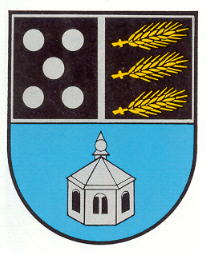Weselberg: Difference between revisions
Jump to navigation
Jump to search
Knorrepoes (talk | contribs) m (Text replacement - "|'''English''' ↵| {{blazon wanted}}" to "|'''English''' | blazon wanted") |
Knorrepoes (talk | contribs) m (Text replacement - "↵{{de1}}↵{{media1}}↵↵'''Literature''': Debus, 1988↵↵[[Category:German" to " '''Literature''': Debus, 1988 {{de1}} {{media1}} [[Category:German") |
||
| Line 25: | Line 25: | ||
The arms symbolize the merger of the three village by the division of the shield in three fields, the three wheat-ears and the three visible sides of the chapel. The balls are taken from the arms of the Lords of Sickingen, to whom the villages belonged until 1793. The wheat-ears refer to the agricultural character and the chapel is a typical building for the municipality. | The arms symbolize the merger of the three village by the division of the shield in three fields, the three wheat-ears and the three visible sides of the chapel. The balls are taken from the arms of the Lords of Sickingen, to whom the villages belonged until 1793. The wheat-ears refer to the agricultural character and the chapel is a typical building for the municipality. | ||
[[Civic Heraldry Literature - Germany|'''Literature''']]: Debus, 1988 | |||
{{de1}} | {{de1}} | ||
{{media1}} | {{media1}} | ||
[[Category:German Municipalities W]] | [[Category:German Municipalities W]] | ||
Revision as of 09:21, 21 July 2023
WESELBERG
State : Rheinland-Pfalz
District (Kreis) : Südwestpfalz
Verbandsgemeinde : Verbandsgemeinde Wallhalben
Additions : 1969 Harsberg, Zeselberg
| German | Durch eine silberne Leiste von Schwarz und Blau geteilt, oben durch einen silbernen Stab gespalten, oben rechts fünf silberne Bollen 2:1:2, oben links drei waagrechte goldene Ähren, unten eine achteckige silberne Kapelle mit schwarzen Fenstern. |
| English | blazon wanted |
Origin/meaning
The arms were granted on March 23, 1983.
The arms symbolize the merger of the three village by the division of the shield in three fields, the three wheat-ears and the three visible sides of the chapel. The balls are taken from the arms of the Lords of Sickingen, to whom the villages belonged until 1793. The wheat-ears refer to the agricultural character and the chapel is a typical building for the municipality.
Literature: Debus, 1988
